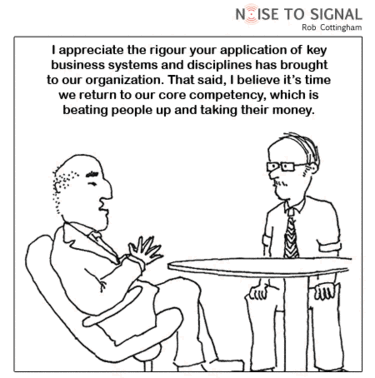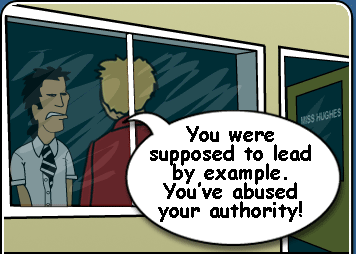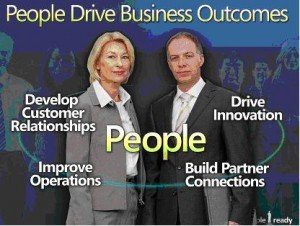Chapter 8
Leading Business Socialutions
Every business leader is looking for ways to contain expenses and increase revenue. In
addition to these two objectives is a host of ongoing business challenges including:
1. Retaining Key Employees
2. Finding New Talent
3. Keeping Customers Happy and
Delighted
4. Product and Service Developments
5. Shareholder and Supplier Relations
Could the Social Web Provide Answers to These Challenges?
The answers to many of these challenges lie within Socialutions--the use of technology and the way people can use it to solve problems and create new value. The opportunities are endless but require new thinking and new methods as a practice of management. A practice that unless embraced could very quickly become the primary cause of business failure.
Just consider how a CEO could easily reduce expenses without cutting people. Using social technologies could dramatically reduce travel cost, meeting cost and marketing cost, yet likely to produce much better results.
The Socialutions answers are right before your eyes, but unless you can envision a new method and understand the power it represents, you cannot comprehend that which you are not aware of or understand.
A Simple Illustration
Seth Godin writes: If oil is $130 a barrel and if security adds two or three hours to a trip and if people are doing more and more business with those far afield…and if we need to bring together more people from more places when we get together…
and if the alternatives, like video conferencing or threaded online conversations continue to get better and better, then…

I think the standard for a great meeting or a terrific conference has changed.
Seth’s point is that the game has changed, as have the rules of the game. There are numerous Socialutions applications available that provide businesses with significant opportunity for reach, richness, collaboration and marketing methods at substantially lower cost than the traditional methods.
Business 3.0 offers business profiles, a virtual exhibit hall, connectivity to customers, suppliers and employees plus a virtual shopping mall. Business 3.0 can be distributed to any social network. GoYoDeo offers the next generation of broadcasting for any business or individual and can be embedded into any social network.
These are just two powerful examples of Socialutions of which business leaders should be taking advantage. In turn, these solutions help leaders deal with the ongoing challenges listed in the beginning of this post.
How Passionate Is Business?
As brands and people flock to the
web, the rate of change grows
exponentially on a daily basis.
From the Big Courting Mergers and
Acquisitions to the little creating
new applications, new communities
and new ideas, the conversations
are swelling like rivers.
This collective attraction is creating
a passion for the future, the next
BIG thing and new ways to
connect, collaborate, and converse
about anything and everything.
The key word here is passion,
which has been missing from the
workforce and in many cases, our
individual lives.
Does Passion Matter?
Passion is an individual and collective emotion that drives people to accomplish and do great things. Passion defined as (emotion), feeling very strongly about a subject or person, usually referring to feelings of intense desire and attraction.
Max Kalehoff, of Online Spin writes in his article titled “Why Passion Matters:”
“Think of the places in your business where the presence of passion really matters — making you stand out beyond the rest, or sink into mediocrity. It’s

about approaching things with the utmost thought and care, versus doing anything less.”
“In my experience, there are a few places in business especially sensitive to passion:”
Listening and understanding your customers and the market.
Innovating based on your market insight and intuition.
Building your product with quality and speed.
Ensuring the highest aesthetic and usability.
Refining your product over and over and over again, until it’s better and better and better.
Paying attention to all the details and signals that comprise the experience.
Inspiring your employees, customers, investors and other stakeholders.
Engaging and collaborating with customers.
Fixing things quickly when they go wrong — and then making them far better.
Using your product yourself and recommending it to friends because you truly believe it’s the best.
Now imagine a business environment where all the people are ignited with passion at serving the needs of the customer, both internal and external. To accomplish this, the organizations would have to adopt Socialutions as its management methods and start fresh with a new perspective about the business.
A Mesh of Principles?
A business is in itself a
social network of people
connecting to create
value collectively both
internally and then
delivering the value
externally. If the value
creation chain breaks
down internally, it affects
the value delivery
externally.
The people within every
business are influenced
by the organization’s culture. The culture is a “mesh” of beliefs and behaviors regulated by the organizations leadership. Whether recognized or not, the culture is driven by a set of principles–spoken and unspoken. People learn to work within the constraints of an organization’s culture which then create social norms
When you look at the social web, you can see a construct of millions of people socializing. This construct creates numerous behaviors represented by the conflicting principles of different affinities to certain values.
As in the physical world, we see people migrating to groups that reflect common principles. Then these groups, and the individuals, produce media that expresses positions and opinions. Collectively, the principles of the group are reflected by the communications within the media produced.
The same concept applies to an organization. Within every business, there are attributes of a social norm reflected by the value system set by management methods. Not unlike the web, businesses represent a “mesh” of principles reflected by the interactions of the people with each other, with suppliers and with customers.
How Does Conflicting Principles Impact Business?
When a business says one thing and does another, it is establishing its own principles of social norms. When a business fails to satisfy customer expectations, the root cause can be found not only in broken processes but also in social norms reflected by employee behavior.
Do we really think employees go to work every day with the intent on delivering poor customer service? No, poor customer service is a result of “systemic disconnects between the people and the processes.”
Can the people change a process? No, only management can institute process changes.
Can the people change the social norms? No, only leadership can change the social norms.
The Socialution for businesses to leverage the advantages of the social web is centric to Leadership principles and management processes. Both of these control and set the social norms of an organization. That is of course if the people believe your product or service truly has value for the customer.
People are designed to serve and willing to do so. People cannot serve when the social norms constrain their ability to do what is a natural human instinct, to serve other people.

How Do You Find the Right People? Recruiting Socialutions!
The economy does not seem to be
improving and housing prices are
dropping (though interest rates
are, too). Common sense would
say there would not be too many
individuals seeking to trade-in
their current jobs for one that you
are offering. The position is still
vacant, and the Director is getting
impatient.
So what is a recruiter to do?
Previously, we discussed fit for
work. Perhaps the first thing to do
is determine whether you are still
a fit with your present position.
Surely, you and your employer
felt you were when you entered
into the employment agreement.
So what has changed?
As we engage The Relationship
Economy, we find many
opportunities to improve how we
do what we do. We also see many opportunities for innovation. However, can we really innovate when we are working at the same place, doing the same thing for the same people repeatedly? Can we tolerate innovation from people who want to work at our company when we know that the people we refer to are not interested in all that newfangled technology? Perhaps, but in the meantime, why not just innovate with what is out there and not worry about something with a bunch of bells and whistles?
Imagine this.
You are looking for people who do a certain job. Where do they hang out? Go there. Make friends with them now. Do not offer them employment; just make friends with them . Do not hide where you work or what you do, but do everything in your power to avoid selling anyone on anything. You are making friends, not finding applicants! This is not your traditional Socialution, but how has that been working for you? Make connections with old friends, meet new friends, and simply talk with all of them to find things in common and build relationships with them. They will find out (they may even ask) what you do. When that happens, tell them - do not sell them.
In addition, for job seekers (Dan Schawbel addresses the idea in more detail, but we have a twist to add to the technology Dan addressed) consider the

virtual resume. Yes, it has bells and whistles, but if that is who you are, would you really be happy working somewhere that did not appreciate your style?
Imagine the cover letter (e-mail) to the employer of your choice . . .
Dear Ms. XYZ
I was excited to learn about the availability of a position with your company that appears to have been designed specifically for me. Here is a link to my e-resume where I can better show you why I got that impression.
Sincerely,
Bob Smith
How Do You Lead Socialutions?
We have been in dialog
with numerous Fortune 500
corporations relative to the
benefits of leveraging social
media. Much of our advice
has been centric to
ensuring that leadership
understands the dynamics
of embarking on any social
initiative before jumping in.
The common issues we
continually encounter are
the comprehension of strategic implications of doing the wrong things and doing things wrong. Many brands consider social initiatives as a tactical initiative to improve relations and enhance brand equity. While fundamentally true, the missing link is not considering the adoption of social tools as a means to transform operations, culture and customer interfaces.
The other misunderstanding is the value to internal resources learning how to use the tools to transform the culture into an ongoing quest for Socialutions for all stakeholders’ benefit.
When Does It Become More Than a Tool?
In any business, the employees usually view new initiatives as a flavor of the month cause initiated by management to cut cost. Attitudes and real transformation of culture and engagement from employees only comes when leaders demonstrate real commitment for change. Commitment is demonstrated by being involved in change and allowing employees to engage in related conversations. Socialutions are maximized when leadership makes

the adoption of social computing as a new way of life within and outside the company
A recent Business Week story titled Big Blue Embraces Social Media demonstrates how attitudes about social media internally can change. IBM
has been encouraging social networking among its employees with in-house versions of Web 2.0 hits such as Facebook and Twitter Already, social scientists are studying the benefits IBMers are getting from the network. They see that it strengthens what are called “weak ties.” These are the people employees might know only casually, some in a different division or down a distant corridor. Getting to know these people, even if it starts out with a Top Five list, widens employees’ range of contacts and knowledge within the company.
Employees also use Beehive for self-branding. It’s a way to strut their stuff for colleagues and managers at the company—whether it’s for a promotion or funding for a pet project.
When do IBMers decide to take the plunge into social networking? Often when their boss takes the lead. Greif says that in recent months a host of top executives at Big Blue have jumped into Beehive, leading many others to do the same.
Leaders lead best by example. People learn best by example. Uniting people aimed at solutions that benefit all stakeholders can only be accomplished through relational examples. Leadership demonstrating a commitment to a common cause and strong belief in a vision of the possibilities is a strong motivation for people to follow, especially if the vision is centric to a Socialution. After all, everything in business has social implications.
Solutions for Business?
Every business has its challenges.
The speed of change fueled by the
demand of “instant answers and
immediate responses” accelerates
the need for solutions. The answer
to successfully managing
challenges remains the same.
However, distracted by the urgency
of the moment, organizations tend
to forget the fundamentals.
Instead, they chase instant fixes or
new initiatives that do not address
the root causes of problems.
So What Are The Fundamentals?
Studies after studies about the top management challenges reveal the following consistent constraints to progress and profitability.
Over half the respondents feel that leaders did not spend enough time communicating with staff.
Six out of ten managers felt their bosses failed to demonstrate trust, show respect for their teams or even manage to produce results.
Six out of ten feel that their managing director or CEO was remote and out of touch.
Nine out of ten managers (93 percent) claim that it is important for them that their employer be enabled to solve customer problems without any organizational constraint.
Seventy-seven percent of employees indicate a strong desire to help solve problems but feel that management won’t let them.
Many organizations are pursuing technology as an answer. However, far from increasing productivity, technology – particularly the Internet and mobile phones – has a largely detrimental effect on managers’ work, with nearly seven out of ten saying they are often snowed under, receiving far too many emails and voicemails.
Are There Socialutions?
Every business is comprised of people and processes. The people work within the processes, and the processes are what enable or constrain people from making progress, improving efficiency, delighting customers and maximizing productivity. The results are measured in profitability, innovation, and progress.
Technology can enable or disable people from optimizing processes, obtaining pride in work and improving overall relations. When technology and cultures restrain progress, they actually make a business environment antisocial.
However, it is not technology in and of itself; rather, it is how technology is used. Social technologies are centric to social opportunities of collaboration, problem solving and enhancing relationships. Social media and related technologies provide the power for any business to harness and aim at breaking down barriers and maximizing communications. Properly planned, implemented and embraced social technologies could provide the means for businesses to reduce complexity, remove the barriers and overcome the challenges. Enable the organization to get closer to the people, suppliers, employees and customers. The result is improved results driven by relationships.

To obtain these benefits, there is one major constraint that must be removed. Leadership of the changes required and management embracing the value of free flowing communications from outside in and from the bottom up must begin. Otherwise, any social media initiative will be viewed by the people as nothing more than an anti-social attempt to appear social.
How Bright Is Future Business?
There is an old saying, “If you stay in this world you will never learn
another one.”
Learning the dynamics, the art and the science of the new world created by the social web is one of the foremost challenges for businesses. Current business theories are correct in their own world, but the problem is that the theory may not make contact with the new world. For businesses to succeed in the new world, a transformation in leadership thinking will be required.
Back to the Future and the 10 Points for Business Transformation Imagine if business leaders were able to go forward in time and learn what needs to be changed today in order to create a better future. Most business leaders would jump at the opportunity to be able to see the future in order to manage today’s decisions better. The future is about Socialutions, and below are the 10 Points for Business Transformation required to survive and thrive in a new world:
1. Management practices of the past have smothered the individual and tried to contain and manage individual expression. The social web brings back the individual.
2. The social web is not a thing, rather it is a movement accelerated by the art of self-expression, the reach of relationships and fueled by the science of advanced technology.
3. Economic activity takes place within social relations. People create economic gains by what they buy and recommend. For businesses to reach buyers, they need to reach people.
4. If you destroy the people of a company, you do not have much left for the future. People drive all business processes, products and services. People influence customer and supplier relations 5. Fear and lack of trust can make economic growth impossible. Do not fear the social web, embrace it. Distrust destroys relationships 6. The social web gives businesses reach and richness in finding innovative answers to perplexing business problems.
7. Businesses are social networks. If you did not know this, you are in denial about the power of people conversing with other people.
8. Human Resource Management is no longer a rules game. People do not resist change–they resist being changed. The traditional approach to human resource practices needs to be transformed to practices that empower people.
9. People have conversations with people, not things. Customers will connect with customers and employees will connect with employees. What are these conversations producing? What can a business learn from these conversations?
10.Remove the barriers to relationships. Lead the transformation or be transformed by it.
Much of our day-to-day life, personal and professional, is interaction with other people, and those patterns of interaction influence much of the events around us and before us. The social web is creating new patterns of interaction, which in turn is creating a new world of social exchanges about everything, anything and between everyone everywhere.
For businesses to survive and thrive in this new world they will need to go back to the future and adopt the Socialutions 10 Points for Business Transformation required to thrive in the new world. The new world is a new game and the rules of the past do not work. Live in the past or embrace the future.
References
Business Week. (2008, May 22). Big Blue Embraces Social Media. Retrieved May 29, 2008, from
http://www.businessweek.com/magazine/content/08_22/b4086056643442.h tm?chan=technology_technology+index+page_top+stories Employers Want You. Retrieved May 29, 2008, from http://jetaany.org/wp-content/uploads/2008/01/uncle_sam_pointing_finger.jpg Godin, Seth. (2008, May 19). The new standard for meetings and conferences blog. Retrieved May 20, 2008, from http://sethgodin.typepad.com/seths_blog/2008/05/the-new-standar.html Insight Image. Retrieved October 7, 2008, from http://www.healthetalk.com.au/indexinsight.htm Kalehoff, Max. (2008). Why Passion Matters. Retrieved May 8, 2008, from http://www.mediapost.com/publications/?fa=l.loginForm Lead by Example Image. Retrieved May 29, 2008, from http://www.explore.parliament.uk/games/consequences/images/humanright s/humanrights_story_26.gif
Noise to Signal Image. Retrieved October 7, 2008, from http://www.socialsignal.com/noise-to-signal
People Drive Business Outcomes Image. Retrieved June 1, 2008, from http://www.taleo.com/blog/images/people%20drive%20biz%20Taleo.JPG
The Future is Bright Image. Retrieved May 29, 2008, from http://ucdavismagazine.ucdavis.edu/issues/su07/graphics/FuturePower.jpg











